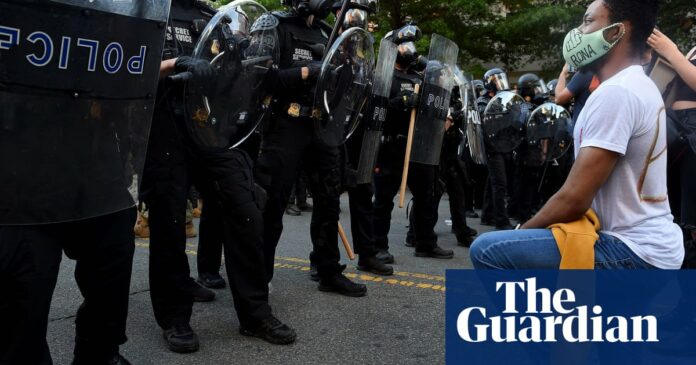Cities witnessed another night of protests despite widespread curfews as sporadic unrest continued across the US one week after George Floyd’s death, which autopsies on Monday ruled was a homicide.
From New York to Washington DC and from Philadelphia to Los Angeles, many communities enacted curfews on Monday, in some cases giving residents just hours’ or minutes’ notice.
In Philadelphia, where the mayor announced a 6pm curfew with about half an hour’s warning, emergency alerts went off in unison on demonstrators’ phones – but they remained undeterred, chanting, “Whose streets? Our streets.”
The US has been rocked by days of civil unrest as protests sweep from coast to coast. Speaking from the Rose Garden on Monday evening, Donald Trump threatened to deploy the military against against demonstrators. And in a startling scene, police used teargas and rubber bullets to disperse crowds of protesters near the White House while Trump spoke, even though the curfew had not yet taken effect.
“If a city or state refuses to take the actions that are necessary to defend the life and property of their residents, then I will deploy the United States military and quickly solve the problem for them,” Trump said during a brief address.
Throughout the nation, cities deployed squadrons of police officers in riot gear and activated national guard teams in response to the demonstrations.
In Washington, protests continued despite a 7pm curfew. An active-duty military police battalion began deploying to the city, according to reports, and Customs and Border Protection (CBP) said it was also assisting with the response, raising concerns about an escalation by law enforcement following a weekend of tumultuous protests that ended with fires near the White House on Sunday night.
In a startling scene, police used teargas and rubber bullets to disperse crowds of protesters near the White House while Donald Trump spoke in the Rose Garden, even though the curfew had not yet gone into effect.
In nearby Baltimore, thousands marched through the city, where five years ago the death of 25-year-old Freddie Gray in police custody sparked days of similarly turbulent demonstrations. In Oakland, California, students, teachers, parents and other locals gathered at a high school, before marching through the city. The Oakland police chief said 15,000 people attended the protest. Maine, one of the whitest states in the US, also saw large demonstrations.
In Minneapolis, where Floyd lived and was killed, thousands gathered peacefully outside the governor’s mansion and moved on to the state capitol. In New Orleans, a large march moved through the city.
In New York, large peaceful protests took place during the afternoon. The evening started with a rally of speeches from residents and activists, calling on people to “take care of your body, they want us to get tired”. But after dark, looting broke out, especially along Fifth Avenue in Manhattan. Videos posted to social media showed numerous stores broken into and ransacked.
In Philadelphia police fired teargas and rubber bullets as a large group of protestors blocked a highway. The confrontation came after the national guard stationed vehicles downtown and officials limited public transit during a third night of curfew.
Earlier in the day, Trump told governors they need to “dominate” the activists protesting Floyd’s killing. The president repeatedly told governors that they needed to get tougher against the demonstrators, sparking alarm among those on the call.
Law enforcement officers across the country have responded to demonstrators by deploying teargas and flash-bang grenades and beating back crowds with batons and rubber bullets. In Louisville, the chief of police has reportedly been fired after officers shot and killed David McAtee, the owner of a local barbecue restaurant, on early Monday morning. Officers fired into a crowd of protesters while their body cameras were turned off.
The mobilization of protesters across the country began one week ago, after video footage circulated of Floyd dying under the knee of a Minneapolis police officer. Two autopsies released on Monday – one from the local medical examiner’s office and one from doctors working with Floyd’s family – agreed that Floyd was killed as a result of being restrained.
The reported from the Minneapolis medical examiner classified the death as a “homicide”. Meanwhile the autopsy conducted privately for Floyd’s family by Allecia Wilson of the University of Michigan and Dr Michael Baden, a former New York City medical examiner, found that Floyd had no underlying health problems that contributed to his death and that he died not only because an officer had lodged a knee on Floyd’s neck for nearly nine minutes, but also because other officers at the scene held him down.






